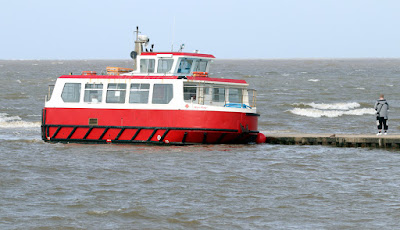What with that stubborn cough, Christmas, New Year and some pretty dire weather that included storm Eleanor, I struggled to get out birding or ringing.
Finally this morning and with a bright start I set out for the usual spots via the road that heads north over Stalmine moss just half-a-mile from home.
After the rain of recent weeks there are a number of flash floods in the stubble fields here with a couple of handy pull-offs/passing places on what is a single track road. There on patch that’s held unpredictable numbers of wild swans, Lapwings and Snipe in recent weeks. Today saw no swans, but 45 Lapwing, 2 Snipe and 2 Ruff.
Ruff by J.M.Garg - Wiki
The Ruff is an interesting record as mid-winter sightings in this part of Lancashire are both unpredictable and irregular and almost certainly involve birds moving westwards from continental Europe at the first signs of cold weather. Should cold weather take hold here these birds may well move south again to join the large numbers of Ruff that winter in West Africa south of the Sahara in the regions of Mali and Senegal.
The Ruff is a common breeding species in Fennoscandia and Russia but breeds in much smaller numbers elsewhere in Europe. In England a few dozen pairs breed in eastern counties but Ruff are more commonly recorded as a spring and autumn migrant across the whole of the UK during March to May and then late July to October.
In the late 1970s early 1980s there was a spring and early summer lek on the North River Ribble adjacent to the British Aerospace plant at Warton, Fylde, about 15 miles away where up to 20 or more Ruff, males and females could be seen resplendent in their summer finery. In some years breeding took place with handfuls of chicks noted on two or three occasions during the early 1980s. Over the years the numbers of Ruff seen there declined following expansion of the aircraft factory, development of nearby land and the subsequent disturbance and the species is no longer recorded there.
There was Corn Bunting sub-song coming from a sparse hedgerow on the other side of the road and when I looked across a gang of five were sat on top taking the early morning sun. There were 15 or so Chaffinches too which flew into the stubble as the buntings stayed around. Both species were still there as I drove off towards Pilling. It’s a little strange that we don’t see Corn Buntings for months but as soon as the New Year arrives, so do the “corn bunts”, a yearly occurrence which suggests that they are birds from further afield and their arrival weather related.
Corn Bunting
I had two lots of seed to drop. The first stop was Gulf Lane where the Linnets numbered 160, plus a couple of Chaffinch and a Skylark. There was a Little Egret and as I sloshed through the pathway a Snipe flew off from my feet. There’s still natural food here for the Linnets with no real evidence of them taking our already two or three bags of seed, most of which has washed into the adjacent ditch where an egret or two is ever present.
Little Egret
High tides and Storm Eleanor have filled Conder Pool to the brim where there are plenty of ducks, but few waders. Best I could do today was 70 Mallard, 150+ Teal, 1 Little Grebe, 1 Goosander but barely handfuls of Redshank, Curlew and Snipe.
At Glasson Dock I counted 250+ Linnets feeding in the field of bird seed mix. Just like the field at Cockerham, the farmer here is paid to plant and manage this small and otherwise out-on-a-limb field for the benefit of birds and insects. Our two Linnet projects currently hold a combined minimum of 400-500 birds which might otherwise struggle to find such a regular and consistent supply of food through the winter months. If only the weather would allow us to catch and mark a few more!
Linnets
But it’s good to see environmental schemes having a positive impact on wintering birds. In an announcement on Thursday, Environment Secretary Michael Gove said that post-leaving the EU Britain will only pay public funds to farmers who provide public benefits such as wildlife habitats or improved soil quality. Good news following a recent string of policy announcements and well received interventions – tighter regulation on puppy farming, CCTV in slaughterhouses, a ban on microbeads and the intention to ban neonicotinoids a pesticide linked to a decline in the bee population.
Meanwhile, on the water adjacent to the village – 36 Tufted Duck, 40 Coot, 1 Great Crested Grebe and 2 overflying Raven from the direction of the marsh.
A circuit of Jeremy Lane/Moss Lane produced 1 Kestrel, 6 Fieldfare and 3 Mistle Thrush. Recent high tides have left a good amount of tide wrack for birds to search and doing just that at Cockersands were loads of Starlings, 15+ Meadow Pipit, 6 Goldfinch, 6 Greenfinch, 2 Reed Bunting, 2 Stonechat, 1 Pied Wagtail and 1 Rock Pipit.
Rock Pipit
Meadow Pipit
We’re promised that the weather may settle down for the weekend. Mind you, it was it was the BBC who said that, so don’t plan too much.
Linking today to
Annni's Birding Blog and
Eileen's Saturday.

















































































